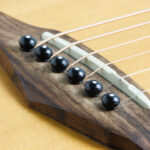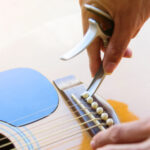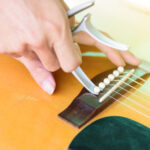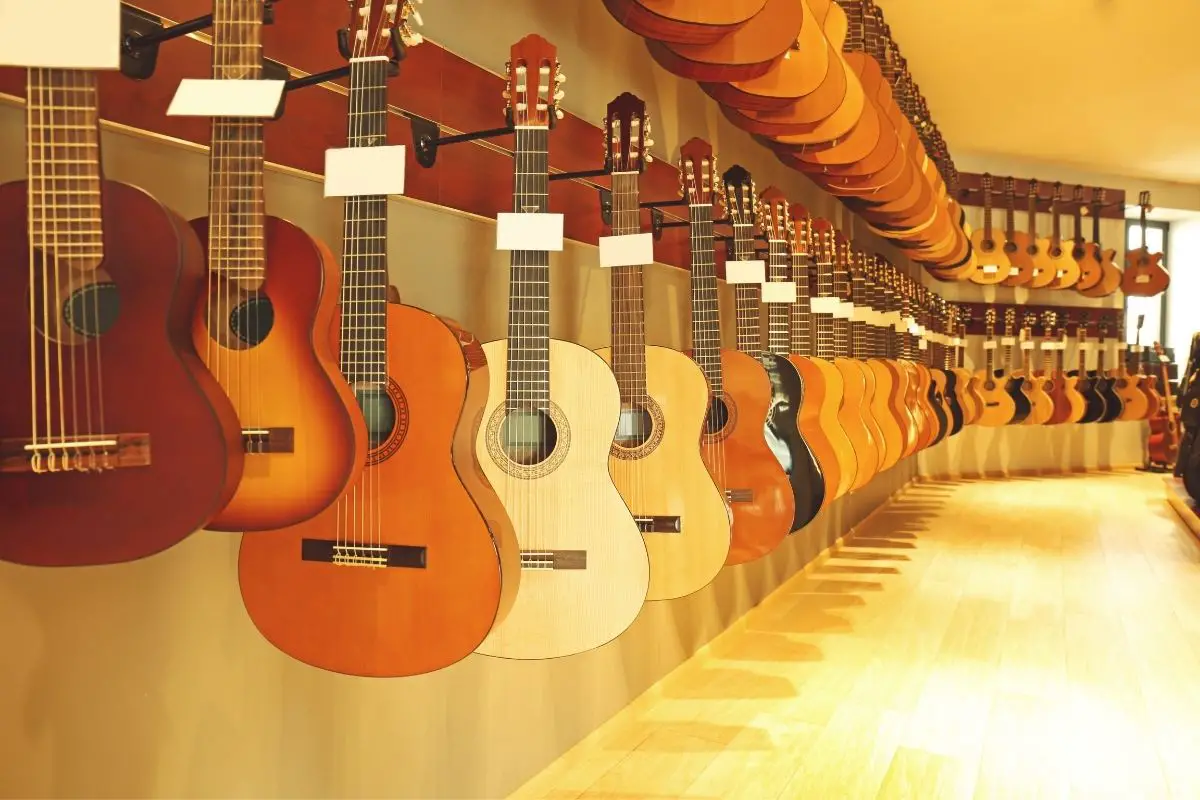Choosing the right bridge pin for your guitar is an important consideration for any player. The bridge pin is a small component that holds the string in place at the bridge, and it plays a significant role in the overall sound and tone of the guitar.
With so many different options available on the market, it can be challenging to know where to start when it comes to selecting the right bridge pin for your guitar.
Understanding the different types of bridge pins available and the materials they are made from is a crucial first step in making an informed decision.
Different materials can have a significant impact on the sound and tone of the guitar, so it’s essential to choose a material that complements your playing style and preferences. Other factors to consider include the size and fit of the bridge pin, as well as the design and appearance of the pin itself.
By taking all of these factors into account, you can make an informed decision that will help you get the most out of your guitar.
Key Takeaways on How Do I Choose a Bridge Pin?
- Understanding the different types of bridge pins and the materials they are made from is crucial when choosing the right bridge pin for your guitar.
- Size and fit, as well as design and appearance, are also important factors to consider when selecting a bridge pin.
- By taking all of these factors into account, you can make an informed decision that will help you get the most out of your guitar.
Understanding Bridge Pins

Bridge pins are small cylindrical components that hold the strings in place on an acoustic guitar. They play a crucial role in the guitar’s tone and overall sound.
Choosing the right bridge pin can make a significant difference in the guitar’s sound and playability. Here are some things to consider when choosing bridge pins for your guitar:
You also shouldn’t miss these other top picks:
- 5 Best Bridge Pins For Acoustic Guitar
- Are Bone Bridge Pins Better Than Plastic?
- Do Acoustic Guitar Bridge Pins Make a Difference?
Material
Bridge pins are made of different materials, including plastic, bone, ivory, wood, and metal. Each material has its unique characteristics and properties that affect the guitar’s tone and sound.
For example, plastic bridge pins are the most common and affordable option, but they often produce a duller sound compared to other materials. On the other hand, bone and ivory bridge pins are known for producing a warmer and more resonant sound.
Size and Shape
Bridge pins come in different sizes and shapes, and it’s essential to choose the right one for your guitar. The size and shape of the bridge pin affect the string’s tension and the guitar’s intonation. A bridge pin that is too small or too large can affect the guitar’s tone and playability.
Style
Bridge pins come in different styles, including plain, dot, and inlayed. The style of the bridge pin can affect the guitar’s aesthetics and overall appearance. Plain bridge pins are the most common and simple, while dot and inlayed bridge pins add a touch of elegance and style to the guitar.
Materials Used for Bridge Pins
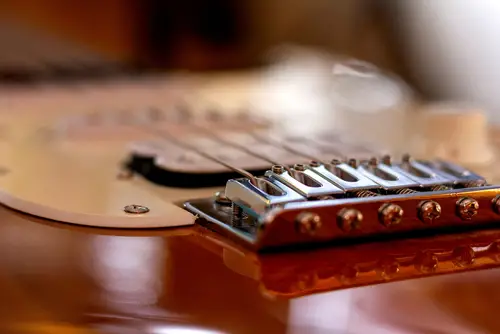
When choosing bridge pins, one of the most important factors to consider is the material they are made of. Here are some of the most commonly used materials for bridge pins:
1. Bone Bridge Pins
Bone is a popular choice for bridge pins due to its natural tonal qualities and durability. Bridge pins made from ox bone or walrus jawbone are particularly sought after for their unique appearance and sound.
2. Plastic Bridge Pins
Plastic bridge pins are a more affordable option and are available in a variety of colors. ABS plastic is a common material used for bridge pins as it is durable and resistant to wear.
3. Wooden Bridge Pins
Wooden bridge pins are another popular choice for their natural appearance and tonal qualities. Ebony, rosewood, and mahogany are commonly used woods for bridge pins.
4. Brass Bridge Pins
Brass bridge pins are known for their bright and clear tone. They are also durable and resistant to wear.
5. Ivory Bridge Pins
Ivory bridge pins are no longer legal to use due to their association with illegal poaching and trade of elephant ivory.
6. Metal Bridge Pins
Metal bridge pins, such as those made from zirconium alloy or liquid metal, are known for their bright and clear tone. They are also durable and resistant to wear.
When choosing bridge pins, it is important to consider the tonal qualities of the material as well as its durability and resistance to wear. It is also important to ensure that the material used is legal and ethically sourced.
Impact of Bridge Pins on Sound
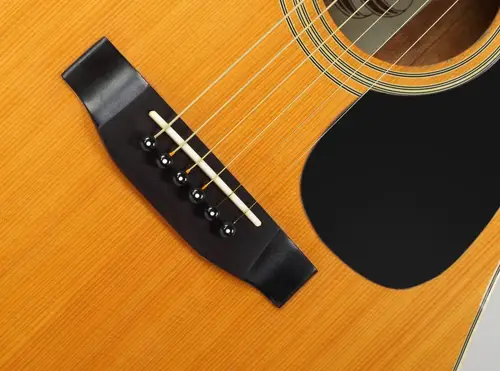
1. Effect on Tone
Bridge pins can have a significant impact on the tone of an acoustic guitar. Different materials and designs can produce different tonal characteristics. For example, brass bridge pins tend to produce a warmer, more mellow tone, while bone or ivory pins can produce a brighter, more articulate tone.
2. Effect on Sustain
The material and design of bridge pins can also affect the sustain of the guitar. Pins made from denser materials, such as bone or brass, can increase sustain, while lighter materials, such as plastic, may reduce sustain.
3. Effect on Volume
Bridge pins can also impact the volume of the guitar. Pins made from denser materials can increase the volume of the guitar, while lighter materials may reduce volume.
4. Effect on Clarity
Bridge pins can affect the clarity of the guitar’s sound. Pins that are too heavy or dense can muddy the sound, while pins that are too light may lack definition.
5. Effect on Brightness
Bridge pins can impact the brightness of the guitar’s sound. Lighter materials, such as plastic, can produce a brighter sound, while denser materials can produce a warmer, darker sound.
6. Effect on Bass
Bridge pins can also affect the bass response of the guitar. Heavier pins can increase bass response, while lighter pins may reduce it.
7. Effect on Treble
Finally, bridge pins can impact the treble response of the guitar. Lighter pins can produce more treble, while heavier pins may reduce treble response.
Choosing the Right Size and Fit

Size of Bridge Pins
When choosing the right size of bridge pins, it is important to consider the diameter of the hole in the bridge plate. The size of the bridge pin should match the diameter of the hole in the bridge plate to ensure a proper fit.
Most bridge pins are available in standard sizes, but there are also custom sizes available for certain models of guitars.
It is important to note that the size of the bridge pin can affect the tone and sustain of the guitar. A larger bridge pin can provide more sustain and a fuller tone, while a smaller bridge pin can provide a brighter tone.
It is recommended to experiment with different sizes to find the best fit for your guitar and playing style.
Fit of Bridge Pins
In addition to size, the fit of the bridge pin is also important. A loose-fitting bridge pin can cause buzzing and affect the overall tone of the guitar. On the other hand, a bridge pin that is too tight can damage the bridge plate or the pin itself.
To ensure a proper fit, it is recommended to measure the diameter of the hole in the bridge plate and compare it to the diameter of the bridge pin. The bridge pin should fit snugly in the hole without being too tight or too loose.
It is also important to consider the material of the bridge pin when choosing the right fit. Different materials can affect the tone and sustain of the guitar, so it is recommended to experiment with different materials to find the best fit for your guitar and playing style.
The Role of Design and Appearance
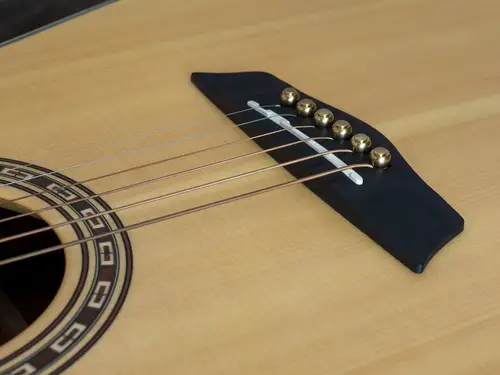
Design of Bridge Pins
The design of bridge pins plays a crucial role in determining the sound quality of a guitar. The shape and size of the bridge pin affect the way the string vibrates, which in turn affects the tone of the guitar.
Bridge pins can be slotted or unslotted, and they can also have flutes or other design elements that affect their performance.
Slotted bridge pins are designed to hold the strings in place, preventing them from slipping out of the bridge. Unslotted bridge pins, on the other hand, do not have slots and are designed to hold the strings in place through tension.
Fluted bridge pins have grooves on the surface that help to reduce the contact area between the string and the pin, resulting in a brighter and more focused tone.
Appearance of Bridge Pins
The appearance of bridge pins is also an important factor to consider when choosing the right bridge pin for your guitar. Bridge pins come in a variety of materials, colors, and designs, and can be plain or adorned with abalone inlays or other decorative elements.
Abalone inlays are a popular choice for bridge pins as they add a touch of elegance and style to the guitar. However, it is important to note that while abalone inlays may look beautiful, they do not necessarily improve the sound quality of the guitar.
In terms of color, bridge pins can be matched to the color of the guitar’s body or chosen to contrast with it for a more striking effect. It is important to choose bridge pins that complement the overall aesthetic of the guitar, but ultimately, the sound quality should be the primary consideration.
Considerations for Durability
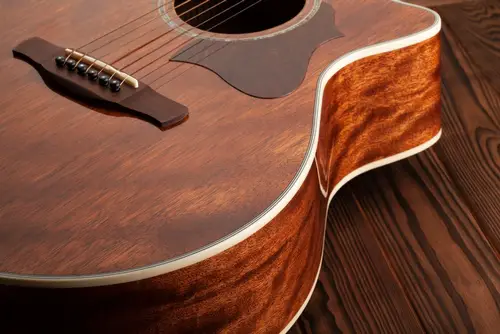
When choosing bridge pins, durability is an important factor to consider. The pins must be able to withstand the tension of the strings and the pressure of the bridge, as well as any environmental factors that may affect their longevity.
Impact of Temperature and Humidity
Temperature and humidity can have a significant impact on the durability of bridge pins. Extreme temperatures can cause the pins to expand or contract, which can lead to cracking or splitting.
High humidity can also cause the pins to swell, while low humidity can cause them to dry out and become brittle.
To ensure the durability of bridge pins in varying temperature and humidity conditions, it is recommended to choose materials that are resistant to these factors.
For example, materials such as bone, ebony, and synthetic materials like TUSQ are known for their stability in different environmental conditions.
Durability of Different Materials
Different materials have varying levels of durability when it comes to bridge pins. While plastic and cheaper materials may be more affordable, they may not be as durable as higher-end materials like bone or ebony.
Bone is a popular choice for bridge pins due to its durability and tonal qualities. It is also resistant to temperature and humidity changes. Ebony is another popular choice due to its hardness and density, which makes it resistant to wear and tear.
Synthetic materials like TUSQ are also a good option for those looking for durability. TUSQ is a type of synthetic ivory that is known for its stability and resistance to environmental factors.
Impact of Extreme Conditions
Extreme conditions, such as exposure to saltwater or extreme heat, can also impact the durability of bridge pins. In these cases, it is important to choose materials that are resistant to these conditions.
For example, stainless steel bridge pins are a good option for those who frequently play in saltwater environments. Stainless steel is highly resistant to corrosion and rust, making it ideal for use in these conditions.
Choosing Based on Brand

When it comes to choosing bridge pins, brand is an important consideration for many guitar players. Here are some popular brands and what they offer:
1. Martin Bridge Pins
Martin is a well-known and respected brand in the guitar world, and their bridge pins are no exception. Martin bridge pins are made from high-quality materials and are designed to enhance the tone and sustain of your guitar. They offer a range of options, including ebony, bone, and plastic pins.
2. Taylor Bridge Pins
Taylor is another popular brand that offers a variety of bridge pins. Their pins are designed to fit their guitars perfectly, but they can also be used on other brands. Taylor offers pins made from materials such as ebony, bone, and plastic, and they come in a range of colors and styles.
3. LMI Bridge Pins
LMI is a lesser-known brand, but they offer high-quality bridge pins at an affordable price. Their pins are made from materials such as bone, ebony, and plastic, and they come in a variety of styles and colors. LMI also offers bridge pins with unique designs, such as abalone inlay.
4. Waverly Ebony Pins 2.0
Waverly is a brand that specializes in high-end guitar parts, and their ebony bridge pins are no exception.
These pins are made from premium ebony and are designed to enhance the tone and sustain of your guitar. They also offer a unique look that can add to the overall aesthetic of your instrument.
When choosing bridge pins based on brand, it’s important to consider factors such as material, design, and price. Each brand offers its own unique benefits, so it’s worth doing some research to find the pins that are right for you and your guitar.
Additional Components and Considerations

When choosing bridge pins for a steel-string acoustic guitar, there are a few additional components and considerations that one should keep in mind.
End Pin
The end pin is the small piece of hardware located at the bottom of the guitar’s body. It serves as an anchor point for the guitar strap and can also be used to attach a pickup or other accessories. When selecting bridge pins, it is important to ensure that they are compatible with the end pin on the guitar.
Some end pins have a larger diameter than others, so it is important to measure the end pin before purchasing new bridge pins.
Strap Button
The strap button is another important component to consider when selecting bridge pins. Some guitars come with a strap button already installed, while others require one to be added.
It is important to ensure that the strap button is securely attached to the guitar before attaching a strap. If the strap button is loose, it can cause damage to the guitar and even result in it falling off.
String Compatibility
When selecting bridge pins, it is important to consider the type of strings that will be used on the guitar. Different types of strings have different gauges, which can affect the fit of the bridge pins.
It is important to ensure that the bridge pins are compatible with the gauge of the strings being used. Using the wrong size bridge pins can result in the strings slipping out of place or the bridge pins becoming damaged.
Making a Choice Based on Budget and Personal Style
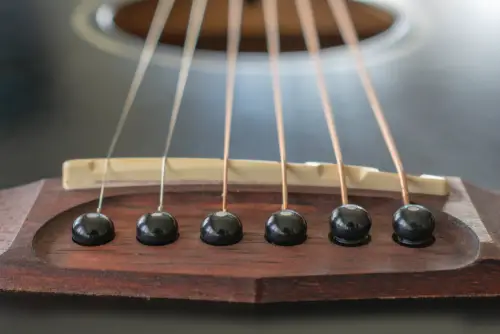
When choosing bridge pins, it’s important to consider both your budget and personal style. Here are some factors to keep in mind:
Budget Considerations
For those on a tight budget, plastic or composite bridge pins are a good option. They are affordable and can be found for as little as a few dollars. However, keep in mind that they may not have the same durability as more expensive materials.
If you have a bit more to spend, brass or ebony bridge pins are a step up in terms of quality. They can cost anywhere from $10 to $50, depending on the brand and style. Brass bridge pins are known for their bright tone, while ebony bridge pins are prized for their rich, warm sound.
For those looking for the highest quality bridge pins, bone or ivory are the way to go. However, these materials are expensive and may not be within everyone’s budget. Bone bridge pins can cost anywhere from $30 to $100, while ivory can cost hundreds of dollars.
Personal Style
When it comes to personal style, there are a variety of bridge pin designs to choose from. Some people prefer simple, understated pins, while others like pins with intricate designs or inlaid materials.
For those who want a classic look, plain brass or ebony bridge pins are a good choice. They are simple and elegant, and will match well with any guitar.
If you want something a bit more eye-catching, consider bridge pins with inlaid materials like abalone or mother of pearl. These pins can be found in a variety of designs, from simple dots to elaborate patterns.
Finally, for those who want a unique and personalized look, custom bridge pins are a great option. These can be made from a variety of materials and can be designed to match your personal style.
Frequently Asked Questions
What are the best bridge pin materials for acoustic guitars?
The most common materials for bridge pins are plastic, bone, and ivory. Each material has its own characteristics that affect the sound of the guitar.
Plastic pins are affordable and easy to replace, but they don’t improve the sound of the guitar. Bone and ivory pins are more expensive but they can enhance the tone of the guitar.
What are the benefits of using bone bridge pins?
Bone bridge pins are popular among guitarists because they are dense and hard, which helps to transfer more energy from the strings to the guitar’s top. This results in a more resonant and fuller sound.
Bone pins also have a natural appearance that complements the look of most acoustic guitars.
Are TUSQ bridge pins a good choice for acoustic guitars?
TUSQ is a synthetic material that is designed to mimic the tonal properties of bone. TUSQ bridge pins are a good choice for those who want the benefits of bone pins without the high cost.
They are also more consistent in quality than bone pins and are less likely to break.
Can you upgrade your guitar’s bridge pins?
Yes, upgrading your guitar’s bridge pins can improve the sound of your guitar. However, it is important to choose a material that complements the tone of your guitar and to ensure that the pins fit properly.
What is the difference between ebony and rosewood bridge pins?
Ebony and rosewood are both dense and hard materials that can improve the tone of your guitar.
Ebony is slightly denser than rosewood and has a brighter tone. Rosewood has a warmer tone and is more commonly used for fingerboards and bridges.
Does the size of bridge pins matter for acoustic guitars?
The size of bridge pins can affect the tone of your guitar. Larger pins can produce a fuller sound, while smaller pins can produce a brighter sound.
However, the difference in tone is usually subtle and the size of the pins should be chosen based on personal preference and compatibility with the guitar’s bridge.

My name is Howard Matthews and I have been playing the guitar since I was knee-high. My parents like to joke that I was pulling the strings even before I was born. In fact, one of my earliest memories is sitting on the couch with my dad’s guitar, wreaking havoc on the chords.
Now, 40 years later, I can attest that I play them much better than I did back then. I have followed in the footsteps of both my parents – much to their delight – and have been the main guitarist in my band for the best part of three decades.
Music has always been my passion, and until recently my life has been so consumed with it that I haven’t had a moment to have a breath (and I wouldn’t have it any other way)!

